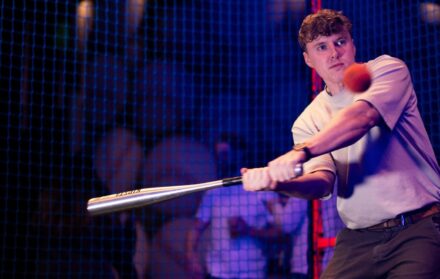
10 Exercises Off the Field to Build Batting Strength
Every baseball player knows the feeling: stepping into the batter’s box, gripping the handle tightly, and hoping all that practice translates into a powerful swing. But there’s a hidden component to success at the plate that can’t be honed solely by taking endless cuts in the cage. The real secret often lies in exercises off the field to build batting strength, a regimen of carefully chosen workouts that develop the muscles, coordination, and body mechanics vital for crushing the ball. By dedicating time away from the diamond to a comprehensive training plan, batters can strengthen their core, hone their explosive power, and stabilize their swing for more consistent contact.
Whether you’re a seasoned slugger or just stepping up to the plate for the first time, the concept of specialized strength training can sometimes feel foreign. After all, batting seems so fundamentally tied to timing and technique—so much so that weightlifting or cardio drills might appear unrelated. However, science and years of baseball wisdom both show that enhanced muscle power, flexibility, and endurance often separate a good hitter from a truly formidable one. You might have perfect hitting mechanics, but if you can’t generate force from your lower body or rotate your core effectively, you’ll struggle to make the ball jump off your bat.
This article introduces 10 distinct workout strategies, each specifically oriented toward the muscle groups and movement patterns that define a robust, dependable swing. You’ll discover how to adapt routines such as resistance training, plyometrics, medicine ball exercises, and even mental conditioning to elevate your game in ways you never imagined. From forging an ironclad grip to boosting your rotational power, these off-field exercises are designed to complement your existing baseball drills, helping you step into the batter’s box with newfound confidence—and, more importantly, the explosive strength to drive the ball with authority.
1. Weighted Resistance Training to Enhance Swing Power

One of the most direct ways to increase your batting strength is by engaging in a structured weighted resistance program. Heavy lifting sometimes gets a bad reputation in baseball circles for risking injury or compromising flexibility, but the truth is that when done correctly, resistance training can significantly amplify your hitting power without limiting your range of motion. The key is targeting the muscle groups most involved in the swing—primarily the legs, back, shoulders, and core—and doing so in a balanced, progressive manner.
Exercises like squats and deadlifts focus on lower-body power, which is a central element of the swing since so much of your torque originates in the hips and legs. Strengthening your legs means you can drive into the ground more effectively, maximizing the kinetic chain that travels from your feet through your hips and into your upper body. When you squat with proper form, maintain a neutral spine, and engage your core, you train your body to generate explosive force—exactly what you need to whip the bat through the zone with speed and control.
Likewise, compound movements for the upper body, such as barbell or dumbbell rows and overhead presses, align well with the demands of batting. A row, for example, engages the lats, rhomboids, and upper back—muscles that promote a stable, upright posture in the batter’s box and help initiate a strong, fluid pull of the bat. Overhead presses work the shoulders and upper back to ensure a robust, balanced posture that can transfer force efficiently. The best part: these lifts also foster better core engagement. If you practice them with free weights instead of machines, you’ll train the smaller stabilizing muscles around your spine and abdomen, which translate to improved control over your swing path.
The secret to making these exercises truly pay off in your batting performance lies in periodization and proper progression. Start with moderate weights and higher reps to build a foundation of muscle endurance. As you become comfortable with the movements and enhance your baseline strength, shift gradually toward heavier weights and fewer reps, emphasizing power. Just keep in mind that the off-season and preseason are the ideal times to push for heavy strength gains. During the season, you’ll likely need to adjust volume and intensity to avoid overtraining. Done judiciously, weighted resistance training becomes a cornerstone that supports each explosive rotation, enabling you to drive the ball with greater authority.
2. Medicine Ball Drills for Explosive Bat Speed
For hitters aiming to develop rotational power and speed, medicine ball exercises stand out as a dynamic training tool. By mimicking the twisting motion essential to a baseball swing, these drills bridge the gap between pure strength training and the nuanced rotational movement that defines batting. While lifting heavy weights builds a strong foundation, the explosive element required to crush a fastball requires muscle fibers to fire rapidly. Medicine ball exercises excel at training this kind of fast-twitch power.
One of the most effective routines involves medicine ball rotational throws. Position yourself sideways a few feet from a sturdy wall or partner. With the ball held at hip level, rotate powerfully from your core and release the ball against the wall. Catch it on the rebound (or have your partner toss it back), and immediately reset for the next repetition. The twisting action approximates the torque you generate during a real swing, strengthening your obliques, lower back, and hips. Perform these throws at various angles—for example, starting from waist-high and also from shoulder level—to ensure a broad range of motion.
Front chest passes with a medicine ball can also be beneficial. Stand upright, hold the ball near your chest, and explosively push it forward toward a wall or partner, focusing on generating power from your core and arms in unison. The motion helps reinforce proper weight transfer and trunk stability, both of which are critical when making contact with a pitch. Another advantage of medicine ball training is the capacity to alter weight and velocity easily. Start with a lighter ball to perfect your form and then graduate to a heavier one once you can maintain explosiveness without compromising technique.
As you become more advanced, you can integrate footwork into your medicine ball drills. For instance, step into your throw, simulating how you’d stride in the batter’s box, and then unleash the rotational force. This addition helps train your mind and body to coordinate all the phases of generating power—leg drive, hip rotation, and torso whip. Over time, you’ll notice a more explosive bat path and a more consistent ability to drive the ball with authority, whether you’re pulling an inside pitch or driving an outside offering the other way.
3. Functional Plyometrics for Better Batting Performance

Plyometrics are a powerful way to develop the quick, explosive movements that translate into better bat speed and overall athleticism. Unlike traditional strength exercises, which focus on controlled lifting and lowering of a load, plyometrics target the rapid stretch-and-contract cycle of your muscles. The resulting improvements in reactivity and power output can be tremendous for hitters, who rely on lightning-fast hip rotation and bat whip to succeed against high-velocity pitching.
Broad jumps, box jumps, and lateral bounding offer an appealing blend of lower-body power and balance training. By propelling yourself off the ground and landing softly, you teach your muscles and connective tissues to store and release energy more efficiently. The better your body can handle these dynamic forces, the more force you can generate when rotating your hips and transferring energy up the kinetic chain to your upper body. Focus on quality rather than quantity when performing plyometric drills—achieve a full extension in your jumps, maintain a stable landing position, and keep reps low to preserve explosiveness.
For batting-specific improvements, consider adding rotational plyometrics that mimic the twisting motion of a swing. Using a cable machine or resistance band attached at waist height, step out sideways and load your hips as if you’re winding up. Then, explode through the resistance in a rotational pattern, letting your torso and shoulders drive the movement. This form of loaded twist jump, or even a jump squat with a rotational element, builds core strength and readies you for the swift pivot required during a swing.
It’s worth noting that plyometric training should be approached carefully to avoid injury. Good joint stability and muscle strength form the prerequisite for safe, effective plyometric work. Warm up thoroughly, emphasizing hip and shoulder mobility, before engaging in high-impact jumps. If you’re new to explosive exercises, start with smaller jumps or lower boxes and prioritize correct landings before advancing. Over time, you’ll discover that these jumps and bounds pay dividends in the batter’s box, where that extra snap in your hips can transform routine contact into hard-hit liners or even long home runs.
4. Grip and Forearm Workouts for Superior Bat Control
While many hitters focus on generating power from their hips and core, the role of grip strength is often overlooked. A powerful grip can be the difference between controlling the barrel through contact and having the bat twist in your hands when you’re a fraction off-center. Strengthening your wrists and forearms not only improves your ability to adjust mid-swing but also contributes to better overall bat speed. If your hands and forearms fatigue less, your swing mechanics remain sharper over the course of a long game or extended practice session.
One simple yet effective method to build grip strength is the farmer’s carry. Select a pair of dumbbells or kettlebells that challenge you while still allowing proper posture. Walk steadily for a set distance or time, focusing on keeping your shoulders back, your core engaged, and your grip firm. The sustained tension in your hands, wrists, and forearms translates directly to improved bat control. Similarly, exercises like wrist curls and reverse wrist curls target the forearm flexors and extensors, enhancing stability around the wrists.
Another underrated approach is the use of hand grippers or rubber grip rings. Short daily sessions with these tools can yield long-term benefits for your overall grip endurance. For a bit more specificity, you can even simulate a batting grip during these exercises, training your hands to clamp down firmly on a shape similar to a bat handle. Some players incorporate thick-bar training, using barbells or dumbbells with a thicker-than-average handle. This requires more hand and forearm strength and can push your grip to new levels.
Hand and forearm strength become especially valuable when you’re trying to direct the ball to different parts of the field or handle pitches that aren’t squarely in your wheelhouse. A subtle wrist adjustment can turn a jam shot into a bloop single or help you keep a borderline pitch fair down the line. Plus, improved grip stability can reduce the risk of overuse injuries like tendinitis, which occur when smaller muscles in the arm get overloaded. With a stronger grasp on the bat, you’ll swing more confidently, trusting that your hands will bring the barrel through the zone exactly as intended.
5. Core Rotational Exercises to Boost Swing Mechanics

When hitters discuss “using the core,” they’re talking about much more than six-pack abs. The core encompasses the abdominal muscles, obliques, lower back, and even parts of the hips and pelvic region. These muscles create the twisting force that allows a hitter to rotate effectively, generating the whip that sends a baseball flying off the bat. Without robust core strength, your swing often becomes arm-centric, diminishing power and reducing your ability to drive through contact.
A versatile approach to core training involves stability exercises like planks and side planks. While these may seem basic, they enforce proper alignment of the spine and engage deep core muscles that support rotational movements. To make them more batting-specific, consider adding a twist or reach. For instance, rotate your upper body while holding a plank, tapping one hand behind your back, then returning to the start position. This subtle rotation challenges your obliques, building the torso strength you need for a potent swing.
Cable woodchoppers represent another staple for rotational prowess. Standing side-on to a cable machine set at either high or low level, grip the handle with both hands and simulate a chopping motion across your body. Focus on leading the movement with your trunk rather than just pulling with your arms. Engage your hips and pivot your feet slightly to train the full rotational chain. These exercises can be done at different angles—diagonally downward, horizontally across the torso, or diagonally upward—ensuring you develop rotational power from every plane.
Beyond strength, balance is crucial. Standing on a balance pad or performing single-leg core drills can force your stabilizer muscles to work overtime, approximating the dynamic shifts in body weight that occur mid-swing. If you consistently train your core rotation while maintaining a solid base, your swing mechanics benefit from a more fluid transfer of energy. This translates into a quick, efficient path to the ball, improved plate coverage, and the ability to barrel up pitches in different locations.
6. Lower Body Strength Training for Driving the Ball
One of baseball’s enduring truths is that the swing starts from the ground up. The lower body—particularly the quads, hamstrings, and glutes—functions as the engine that initiates your momentum forward (or sometimes in a load and explode pattern). When your legs are strong and well-coordinated, you can effectively harness the ground reaction forces that become the driving power of your swing. Weak or undertrained legs often lead to poor weight transfer, causing hitters to lunge or lose stability.
Squats are a classic exercise that yields significant benefits for batters when performed correctly. The back squat, in particular, builds raw strength in the quads, hamstrings, and glutes. Maintaining a braced core and a neutral spine ensures the movement trains your lower body in harmony with your trunk. Front squats offer a slightly different challenge, placing greater emphasis on the quads and forcing a more upright torso—useful for hitters who want to remain tall in their stance.
Lunges and split squats provide a unilateral component that’s especially beneficial. Many motions in baseball, including striding toward the pitch, are unilateral in nature, meaning one leg often bears a different load than the other. By practicing lunges—forward, backward, or lateral—you help each leg develop its own strength and stability, reducing imbalances that can hinder your swing or lead to injuries. Add a twist to the movement by holding a weight on one side of your body, forcing your core to resist rotation and bolstering your trunk stability.
Don’t underestimate the role of the glutes in generating power. Movements like hip thrusts or glute bridges isolate this muscle group, which is key for hip extension. The stronger your gluteal muscles, the better you can explode through the lower half, whipping your hips around to unleash the bat head. Together, these lower-body exercises do more than just buff up your legs. They lay the groundwork for a consistent weight shift, stable stance, and explosive push-off—essentials for producing the launch of the bat through the zone.
7. Upper Body Stabilization: Push-Ups, Pull-Ups, and Beyond

While the core and lower body supply much of the power behind a swing, a strong and stable upper body ensures that energy isn’t lost en route to the barrel. From the shoulders to the upper back and chest, every link in the upper body’s chain must be sturdy enough to handle the high-speed forces of a full swing. That’s where classic bodyweight exercises like push-ups and pull-ups come into the picture, forming the foundation of upper body strength and stability training.
Push-ups are deceptively effective. Performed properly—hands slightly wider than shoulder-width, body in a straight line, core engaged—they target the chest, shoulders, triceps, and even your upper back to a degree. They also demand a strong midsection to keep your hips from sagging. Variations like diamond push-ups or decline push-ups can shift the emphasis to different muscle groups, ensuring a well-rounded approach. Then there’s the pull-up, an exercise that builds the lats, biceps, and upper back. This “pulling” strength not only helps with bat control but also complements “pushing” actions to balance the shoulders.
Beyond these staples, incorporating single-arm presses or rows can further refine your coordination and strength balance. Single-arm dumbbell presses or single-arm bent-over rows mimic the unilateral demands of baseball. Each arm works independently, revealing any imbalances that might throw off your swing or invite injuries. Similarly, a suspension trainer—like TRX straps—lets you perform rows, chest presses, and more with a constantly shifting center of gravity, challenging your stabilizer muscles every step of the way.
Exercise selection doesn’t need to be exhaustive. The goal is to pick a few key movements that reinforce proper posture and upper-body coordination, then perform them consistently. For many players, that might look like a circuit of push-ups, pull-ups, and rows, plus a finishing set of shoulder external rotations with a band to keep the rotator cuff healthy. As you progress, you might add weights or complexity, but the underlying principle remains: a stable, powerful upper body helps channel the force generated by the legs and core right into the bat, minimizing energy leakage and maximizing the velocity of your swing.
8. Flexibility and Mobility Routines for Smooth Follow-Through
A powerful swing relies on free, uninhibited movement through the hips, spine, and shoulders. Tight or restricted muscles can sabotage an otherwise perfect batting stroke, causing you to lose torque, misalign your swing path, or even sustain injuries. Flexibility and mobility routines are thus a critical complement to strength-focused training, ensuring each muscle group can move through its full range of motion under control.
Dynamic stretching is often the first step, especially before any intense practice or lifting session. Instead of static holds, dynamic stretches involve controlled, sports-specific motions. For batting, leg swings, hip openers, and thoracic spine rotations can help “unlock” your body for rotational movements. Think about a leg swing where you gently move the leg forward and backward or side to side, ramping up the range as you feel warmer. This primes the hips and hamstrings for the explosive steps and pivots integral to a powerful swing.
Foam rolling also serves as a valuable tool. Rolling out your quads, IT bands, and upper back before and after activity can relieve tight spots that limit mobility. The consistent pressure from a foam roller helps break down adhesions in the muscle fibers and fascia, leading to improved circulation and range of motion. Pair this with hip mobility drills—such as the pigeon stretch or the couch stretch—to target common problem areas. By loosening up the hips, you lay the groundwork for a fluid weight shift and follow-through.
Shoulder and thoracic mobility shouldn’t be overlooked, given how crucial upper-body rotation is in the swing. Exercises like the open book stretch—where you lie on your side, knees bent, and rotate your upper body open while keeping your lower body stable—boost thoracic spine flexibility. If your mid-back is locked up, you’ll struggle to achieve the rotational range needed for a smooth, powerful swing. Making time for these mobility routines might feel tedious, but the payoff becomes evident the moment you realize you can reach that outside corner pitch without compromising your mechanics or losing power.
9. Coordination and Balance Drills for Improved Plate Coverage

Batting isn’t merely about raw power—it’s also about finely tuned coordination and the ability to adjust your swing path mid-flight when the pitch doesn’t end up exactly where you expected. That’s where coordination and balance drills come into play. While core strength and leg drive set the stage for powerful contact, a refined sense of body awareness allows you to track changing ball speeds and movement, then make micro-adjustments for solid contact.
One straightforward way to refine coordination is through single-leg balance drills. Stand on one foot while performing movements like light dumbbell curls or overhead presses. The unstable base forces you to activate countless stabilizing muscles in your legs, hips, and core, cultivating the sense of equilibrium vital for swinging from a firm base. If you find yourself swaying in the batter’s box or struggling with timing, this kind of practice can help you remain steady and ready to fire your hips at the right moment.
Hand-eye coordination drills should also be a staple. Juggling tennis balls or using reaction balls that bounce unpredictably can sharpen your reflexes and build a robust visual-motor connection. While these may feel like games more than workouts, they effectively train your brain to process movement patterns quickly—a crucial skill when deciding whether to swing at a 90-plus mph fastball or lay off a curve in the dirt. For a baseball-specific twist, try a drill where someone tosses colored wiffle balls and calls out a color, requiring you to hit or avoid the ball based on the verbal cue.
Lateral movements also enhance your ability to shift weight quickly, which might be the difference between pulling an inside pitch or going the other way on an outside pitch. Lateral bounds, shuttle runs, or even quick-skater hops help with side-to-side agility, reinforcing your capacity to adjust swing angle spontaneously. When these components—balance, coordination, and spatial awareness—mesh with your strength and power base, you become a versatile hitter capable of reacting to a pitcher’s plan and exploiting any small mistake in location.
10. Mental and Endurance Training for Consistent Hitting
While physical preparation commands much of the spotlight, the psychological and endurance aspects of batting often determine how well you utilize that physical power over a full game, or even an entire season. Mental focus can ebb and flow if you’re not actively training it, leading to lapses in concentration at crucial moments. Likewise, if your cardiovascular endurance is lacking, fatigue can set in late in the game, making your mechanics sloppy and your reaction times slower.
To address mental resilience, consider integrating short meditation or visualization sessions into your training routine. Spend a few minutes each day picturing yourself driving pitches to different parts of the field or staying poised under high-pressure situations. Visualization isn’t just daydreaming; it primes the brain to activate the correct neuromuscular pathways when you actually step into the box. This mental rehearsal helps combat the psychological fatigue that can build up from repeated failures or external distractions.
On the endurance front, moderate cardio sessions—like a 20–30 minute steady run or interval training—can improve your overall stamina. Baseball might not require continuous running like soccer or basketball, but you do need to keep your energy levels high throughout multiple at-bats. An extra surge of cardiovascular fitness can also aid in postural endurance; if you’re exhausted, your stance might deteriorate, leading to compromised swings. High-intensity interval training (HIIT) is especially productive for baseball players because it mimics the explosive bursts of activity followed by short rest periods characteristic of the sport.
A final piece of mental and endurance training is learning to recover from mistakes quickly. This “mental bounce-back” can be cultivated by setting small, process-oriented goals—focus on executing your load and stride rather than obsessing over your batting average. When every swing becomes a learning opportunity rather than a do-or-die test, your mind stays fresh, allowing you to apply your physical strength and coordination effectively. Over time, these techniques forge a more resilient hitter who remains calm and effective, even when adversity strikes or fatigue sets in.
Conclusion: Achieve Peak Power Through Off-Field Exercises

Building a fearsome swing isn’t just about swinging a bat more often; it’s equally about forging the strength, agility, and mental composure that enable you to maximize your potential. The exercises off the field to build batting strength highlighted here—ranging from heavy resistance lifts to targeted mobility work—provide a roadmap for any hitter seeking to up their game. Each workout method addresses distinct but interconnected parts of your swing. Weighted resistance training lays the brute-strength foundation, while medicine ball drills and plyometrics channel that strength into explosive rotational power. Grip exercises give you command over the bat, and refined core workouts ensure your hips and torso rotate like a well-oiled machine.
However, remember that growth in athletic performance is seldom linear. Your body will adapt to new demands in phases, and there may be periods of soreness, or even slight regressions, before breakthroughs emerge. Smart programming matters—plan your workouts so they complement each other rather than overload your muscles. If you’re in-season, you might dial down the intensity to maintain freshness and prevent fatigue. In the off-season, you can push harder, aiming for gains that will have you launching balls further when the games resume.
Just as importantly, don’t neglect the mental and endurance aspects of batting. The difference between a groundout and a booming double off the wall often lies in your ability to maintain focus when a pitcher tries to jam you inside or fool you with a curveball in the dirt. By reinforcing core principles—visualizing success, mastering your breathing, and keeping your heart rate in check—you equip yourself to thrive under pressure. Endurance workouts add another dimension by preventing the late-game fatigue that can rob you of your best swings.
In the end, a powerful, consistent swing emerges not just from batting cages and live pitching, but from the cumulative impact of carefully chosen off-field workouts. Commit to these exercises with patience and dedication, and you’ll discover that each stride in your lower-body training, each set of core rotations, and each rep of a grip-strength routine melds into a cohesive whole. You’ll walk into the box with a stable stance, unshakable confidence, and the kind of swing that pitchers dread to face—one powered by science, discipline, and the unwavering drive to excel as a hitter.





